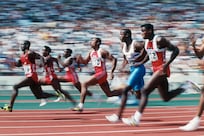A bluffer's guide to the Three Colours trilogy.
The Polish director Krzysztof Kieslowski made two of the most influential film cycles in modern times. Dekalog came first in 1989 and 1990. Then, in 1993 and 1994, came his Three Colours trilogy: Blue, White and Red, with each colour taken from the French flag. In a unique collaboration between major European film festivals, Blue debuted at Venice, White at Berlin and the final part, Red, premiered at Cannes. Kieslowski started as a director of documentaries before making his first feature film, Personnel, in 1975. His works are famous for focusing on moral and metaphysical issues.
At the press conference at the Cannes Film Festival in 1994, the 52-year-old Kieslowski surprisingly announced that Three Colours: Red, starring Irene Jacob, would be the last film he would direct. The story of the friendship that grows between a young Swiss model and a retired lawyer and its surprising denouement ties together the trilogy. Two years after completing Red, Kieslowski unexpectedly died after suffering a heart attack.
Valentine (Irene Jacob) is 10-pin bowling. The camera follows the bowling ball down the lane and, as we pan back to our main protagonist, the camera surprisingly sweeps left and stops at a different lane where a crushed cigarette packet sits next to a broken glass. The cigarettes are a reference to Valentine's neighbour Augustine, a lawyer, and the glass is used as a motif for broken relationships. The final scene, in which it is revealed that all of the characters from the trilogy are linked because they are the only survivors of a ferry accident, is the most famous and, because of the use of chance, controversial moment.
Juliette Binoche turned down a role in Stephen Spielberg's Jurassic Park to appear in Three Colours: Blue. Julie Delpy was surprised to be offered a part in White after she turned down a role in Blue because she didn't feel comfortable with the script. But there was no such dilemma for Jacob; Kieslowski even allowed her to choose her character's name. She chose Valentine because it was her favourite name from her childhood.
As well as being named after the colours of the French flag, each film represents one part of the French motto, "Liberty (blue), equality (white), fraternity (red)".
Although the composer Zbigniew Preisner collaborated a number of times with the director, it's his work on the Three Colours trilogy that is his masterpiece. His Song For the Unification of Europe is an important part of the plot in Blue and his music in Red includes a setting of Polish and French versions of a poem by Poland's Nobel Prize winning poet Wislawa Szymborska.
After Blue won the Golden Lion for Best Film in Venice and White won the Best Director gong in Berlin, it was a surprise when Red picked up no awards in Cannes. However, Red was by far the most successful of the trilogy at the box office.
Red is the culmination of a great cinema career and a fitting final work. Kieslowski used colour in a way that is akin to painting, and by doing so created a completely new cinematic language. The 1990s British punk rock band 3 Colours Red was named after the film.






